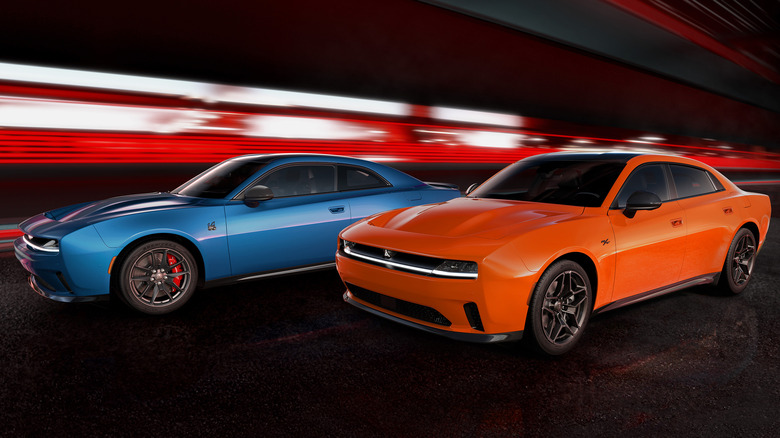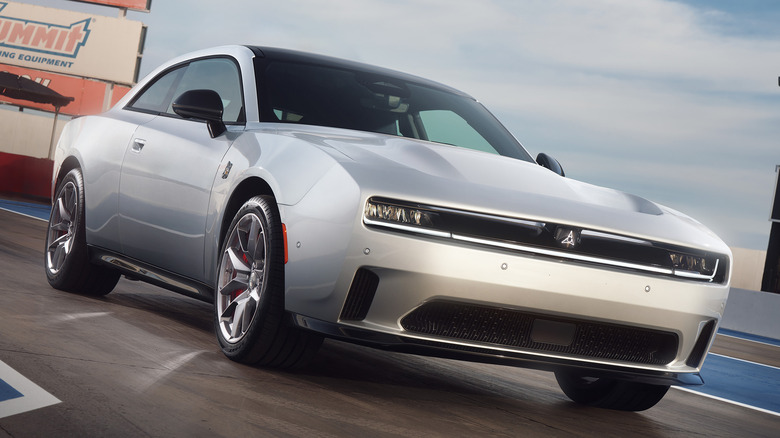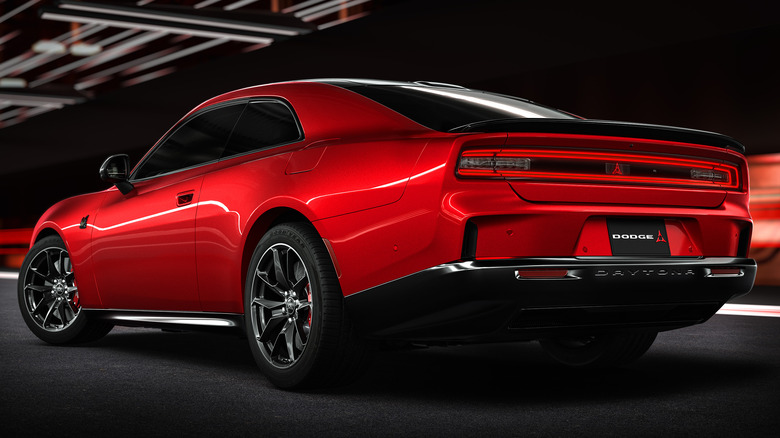Dodge Charger Daytona Vs. Sixpack: What's The Difference Between These Next-Gen Muscle Cars?
Legacy automaker Dodge has unveiled the electric future of the "Brotherhood of Muscle" without alienating die-hard fans of good ole' internal combustion engines. The all-new Dodge Charger Daytona will electrify the legendary name with two high-powered variants, two electric motors, a performance battery pack, and a Fratzonic chambered exhaust that the carmaker promises will sound like there's a gas-guzzling V8 under the hood.
Meanwhile, Dodge also revealed the Charger Sixpack for muscle car fans who aren't ready to embrace recharging cords. We still mourn the loss of Dodge's Hemi V8 engines, but the Charger Sixpack makes up for it with a standard or high-output version of the Stellantis group's 3.0-liter twin-turbocharged Hurricane inline-six.
The powertrain is the primary difference between the Dodge Charger Daytona and Charger Sixpack. Both are riding on an all-new STLA Large platform that offers the flexibility of accommodating electric, hybrid, or internal combustion powertrains. Moreover, the Charger Daytona EV and Charger Sixpack will arrive in a two-door or four-door body style. Production of the two-door Daytona EV is underway, while the four-door sedan will trickle into Dodge dealerships in 2025.
Dodge Charger Daytona EV: Electric muscle car
Dodge will release two versions of the Charger Daytona EV: The R/T and Scat Pack trims. The former has two electric motors and an all-wheel drivetrain that produces 456 horsepower and 404 lb-ft of torque. There's a "Power Shot" mode like in a Dodge Hornet R/T that unleashes 496 horsepower for 15 seconds. With those numbers, the Daytona EV R/T could scamper from 0-60 mph in 4.7 seconds, and reach the quarter mile in 13.1 seconds.
On the other hand, the Daytona EV Scat Pack has a more potent twin-motor electric powertrain that churns out 630 horsepower and 627 lb-ft of torque. It also has Power Shot that temporarily bumps up the horsepower output to 670. Dodge said the Scat Pack could rush to 60 mph in 3.3 seconds, and conquer the quarter mile in about 11.5 seconds. Power comes from a burly 100.5 kWh lithium-ion battery with a unique nickel and cobalt chemistry to deliver an estimated 317 miles (R/T) and 260 miles (Scat Pack) of range.
Dodge Charger Sixpack: Gas-powered goodness
The Dodge Charger Sixpack is the antidote if you're still hesitating to take the EV plunge. It will arrive at dealerships in Standard Output (S.O.) and High Output (H.O.) versions of the brand's 3.0-liter twin-turbo Hurricane inline-six, an engine that first saw action in the new Ram 1500 and Jeep Wagoneer/Grand Wagoneer.
The Charger Sixpack S.O. has 420 horsepower, but the H.O. variant will have up to 550 horsepower. An eight-speed automatic transmission and all-wheel drivetrain are standard across both S.O. and H.O. variants of the Charger Sixpack, and Dodge claims both have more gravitas than the discontinued 5.7 and 6.4-liter Hemi V8 engines of the old Charger R/T and Scat Pack.
Moreover, the Sixpack will have moderate exterior differences with the all-electric Charger Daytona. The changes include custom bumpers and a bespoke front grille. The standard features will most likely mirror those in the Charger Daytona, including a 10.3-inch digital instrument cluster and a 12.3-inch infotainment touchscreen.


